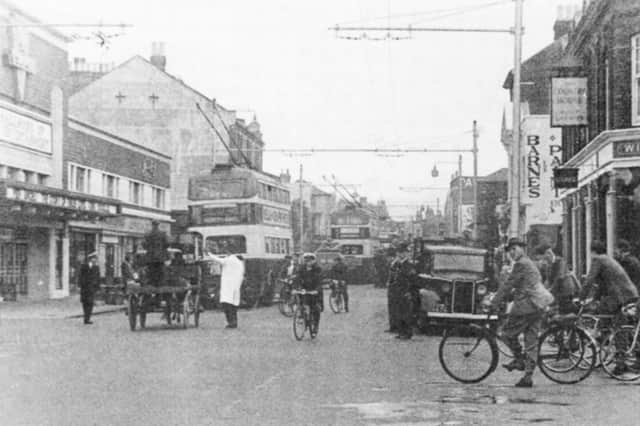Chaos of the 1950s’ morning commute in Portsmouth | Nostalgia


‘Wrong’, says Richard Newman, of Drayton.
He tells me: ‘The view of the Savoy C inema and Country House pub was taken circa 1953.
‘It was a going to work scene rather than going home as the cyclists coming from All Saints Road on the right are heading for the dockyard, either in the morning or returning to work after lunchtime.
Advertisement
Hide AdAdvertisement
Hide Ad‘The photo shows three trolleybuses, all on Specials, on short workings as the main destination blinds are turned blank, as was the custom.
‘The last trolleybus service along Commercial Road was in 1960 (service 19/20 & dockyard specials).
‘The wiring was kept in place for evening depot workings back to North End until 1961.
'The bus nearest camera has the advert “Use gas for cheaper hot water”.
Advertisement
Hide AdAdvertisement
Hide Ad‘This disappeared in the 1950s, presumably when gas prices increased.
‘This part of the road, from Mile End House School southwards to Lake Road, was congested in the morning peak with lorries unloading and loading at the wholesale fruit and veg merchants.
'As a result of this chaos, motor buses, both Southdown and Corporation, were diverted via Fitzherbert Road (seen on the left), Flathouse Road, and the Unicorn Gate, then down Unicorn Road to Edinburgh Road until about 9am, for the benefit of dockyard workers.
‘These roads were never wired for trolleybus working, they had to manoeuvre around the vegetable lorries.
Advertisement
Hide AdAdvertisement
Hide Ad‘The totters horse-drawn cart shown behind the nearest trolleybus was then a familiar sight around the city.
'I am somewhat perplexed as to why there are three trolleybuses lined up.
‘Had there been an accident further along the road or, perhaps, a power cut?
‘This was a rare occurrence which immobilised vehicles.
‘Perhaps the distant bus had been brought to a standstill by losing its trolleyhead or damaged wiring.
Advertisement
Hide AdAdvertisement
Hide Ad‘The photo is no doubt the work of respected Evening News photographer Vic Stewart.’
• Raymond Hallett has sent me some marvellous memories of the Crasswell Street area of Landport.
‘If you lived in the Crasswell Street area in the 1940s then I can more than relate to your latest item about the Havelock pub in Crasswell Street.
‘I lived opposite the Dial pub in the block of flats ca lled Denmead House, at No 9.
‘The Havelock was on the corner of Landport Street.
‘The other end of the street was Jon’s, a Polish barber.
Advertisement
Hide AdAdvertisement
Hide Ad‘Opposite the Havelock was a stone mason's yard which was near the undertaker’s, called Stapleford’s.
‘On the next block, same side as the Havelock, was the Dial pub which had a small flat roof which we used to climb up to mainly to get back the footballs.
‘Opposite the Dial was Mr Mills’ fruit and veg shop.
‘They used to have a horse and truck which the son, Roy, would use to deliver logs and coal down the street.
‘Then you come across the Egremont pub.
‘On one side was St Faith’s church hall.
‘On the other side was a small bomb site and the stables and yard where Roy Mills kept his horses.
Advertisement
Hide AdAdvertisement
Hide Ad‘I used to help chopping the logs and firewood and mucking out the stables.
‘Opposite the yard was the road that took you down to the pub called the Mars.
‘In the picture you published last week it showed the Mars where we would go into the small side door and get our 1d packets of broken crisps.
‘If you went past the Egremont pub you could go into the back entrance of Arundel Street School.
Advertisement
Hide AdAdvertisement
Hide Ad‘A little bit further on was another small stable which was owned by a Mr Jimmy Phillips, and opposite was the grocers which sold fruit and veg, plus oil for the fire.
‘Further on you would come into Commercial Road.
‘There were always lots American sailors or Yanks, as we called them.
‘We used to say to them, "got any gum, chum?”.
‘Each year when the elections were on lots of us kids would get on the horse and carts and sing out “Vote, vote vote for Mr Tiveridge”.
‘Brigadier Terence Clarke was a Conservative and when he went electioneering they would knock at the door and people would say: “Whose that knocking on the door?
“If it’s Clarke and his wife stab them with a knife and they won’t need votes any more”.’